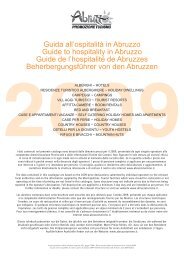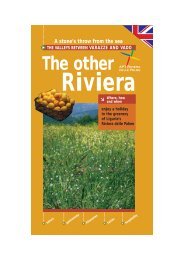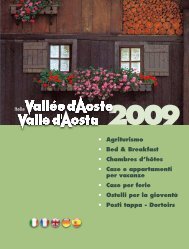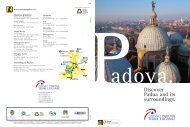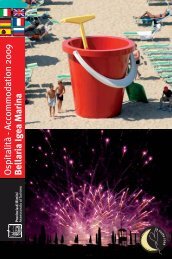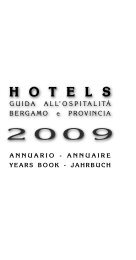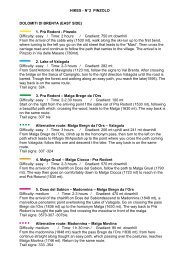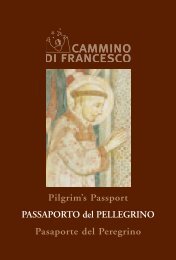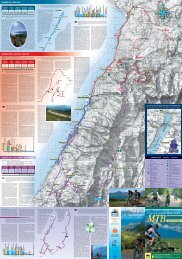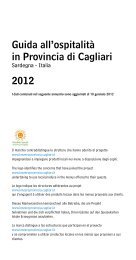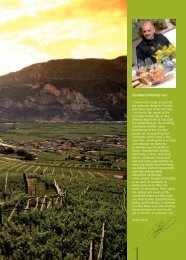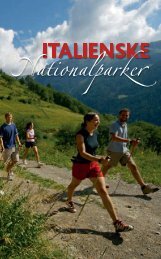APPENNINO BOLOGNESE. MAPPA TEMATICA - Emilia Romagna ...
APPENNINO BOLOGNESE. MAPPA TEMATICA - Emilia Romagna ...
APPENNINO BOLOGNESE. MAPPA TEMATICA - Emilia Romagna ...
Create successful ePaper yourself
Turn your PDF publications into a flip-book with our unique Google optimized e-Paper software.
N<br />
S<br />
Spas & Health<br />
Sports<br />
Provincia di Bologna<br />
Assessorato al Turismo<br />
Via de’ Castagnoli, 3 - 40126 Bologna<br />
Tel. +39 051 6598761 - Fax +39 051 6598760<br />
turismo@provincia.bologna.it<br />
www.provincia.bologna.it/turismo<br />
Project co-financed by GAL Bolognappennino - Leader + Programme<br />
Tourist offices and information points<br />
Lizzano in Belvedere<br />
Piazza Marconi, 6 - 40042 Lizzano in Belvedere (BO) - tel +39 053451052; fax +39 053451052<br />
iat.lizzano@comune.lizzano.bo.it - www.comune.lizzano.bo.it<br />
Vidiciatico<br />
Piazza XXVII Settembre, 8 - 40042 Vidiciatico (BO) - tel +39 053453159; fax +39 053453159<br />
iat.vidiciatico@comune.lizzano.bo.it - www.comune.lizzano.bo.it<br />
Porretta Terme<br />
Piazza della Libertà, 14 - 40046 Porretta Terme (BO) - tel +39 053422021; fax +39 053422328<br />
iat@comune.porrettaterme.bo.it - www.comune.porettaterme.bo.it<br />
Monghidoro<br />
Via Matteotti, 1 - 40063 Monghidoro (BO) - tel +39 0516555132; fax +39 0516552268<br />
turismo@tuttoservizispa.it - www.tuttoservizispa.it<br />
Sasso Marconi<br />
Via Porrettana, 312 - 40037 Sasso Marconi (BO) - tel +39 0516758409; fax +39 0516758408<br />
infosasso@cittacastelliciliegi.it<br />
Zola Predosa<br />
Via Masini, 11 - 40069 Zola Predosa (BO) - tel +39 051752472; fax +39 051752472<br />
info@iatzola.it - www.iatzola.it<br />
Imola<br />
Via Mazzini, 14 - 40026 Imola (BO) - tel +39 0542602207; fax +39 051602310<br />
iat@comune.imola.bo.it - www.comune.imola.bo.it<br />
A course of fire and<br />
potent curative<br />
waters, generated by<br />
natural underground<br />
phenomena: this is<br />
the Way of the<br />
Spas, a magical<br />
route which crosses the Apennines,<br />
leading to spa cities, dating back to<br />
antique traditions, and specialized<br />
health centres in the Bologna<br />
Province.<br />
Halfway between Bologna and<br />
Florence, travelling along the<br />
beautiful SS 64 “Porrettana”<br />
highway, you come to Porretta<br />
Terme. Surrounded by atmospheric<br />
woods, Porretta is famous for the<br />
extraordinary properties of its<br />
waters. In existence for two<br />
thousand years, the legend recounts<br />
that a sick ox returned to his owner,<br />
having recovered after drinking from<br />
the “Puzzola” (“Polecat”) spring, thus<br />
leading to the discovery of its<br />
curative properties. Ancient thermal<br />
baths appreciated by the Etruscans<br />
and Romans, where Machiavelli<br />
stayed in the period of writing his<br />
play “La Mandragola” and where<br />
nobles, intellectuals and guests from<br />
all over Italy used to stay during the<br />
Belle Époque. The waters from its<br />
springs contain sodium and iodine<br />
chloride, making Porretta an<br />
important centre for well-being still<br />
today, with high quality hotels and<br />
health centres.<br />
Info: Porretta Terme<br />
Moreover, in the area of<br />
Monterenzio (San Clemente),<br />
15 kms from the Via <strong>Emilia</strong>,<br />
immersed in spectacular natural<br />
beauty, there is a spa centre<br />
equipped with beauty centre and<br />
congress facilities. Connected to<br />
the spa, there is also the summer<br />
water-park: 15 different pools and<br />
the first ever thermal complex<br />
for children.<br />
Info: Monghidoro<br />
Golf<br />
Particularly stimulating is the<br />
combination of thermal treatment<br />
and golf. The greens and fairways of<br />
the Apennines are not only for golf<br />
fans, but genuine oases of relaxation<br />
for everyone. As well as the golf<br />
school in Castel di Casio, there are<br />
two golf clubs:<br />
. Bologna Golf Club<br />
in Monte San Pietro, info:<br />
051.969100, www.golfclubologna.it,<br />
a historical course designed by<br />
Cotton & Harris on the hills a few<br />
kilometres from Bologna. In 2000,<br />
there were important modifications<br />
to the course by Peter Alliss.<br />
Technical data: 18 holes, par 72,<br />
5,949 metres, 116 metres above sea<br />
level.<br />
. Molino del Pero Golf Club<br />
in Monzuno, info: 051.6770506,<br />
www.molinodelpero.it, opened<br />
in 1991, offers a highly technical<br />
challenge, extremely enjoyable even<br />
for the most expert. The ascent to<br />
the opening holes, rising steeply up<br />
the slopes of the Savena valley,<br />
has often been referred to in<br />
international magazines as<br />
“the stairway to heaven”.<br />
Technical data: 9 holes, par 35, 2,610<br />
metres for men and 2,310 for women,<br />
300 metres above sea level.<br />
Snow Sports<br />
On the mountain<br />
range between<br />
Tuscany and <strong>Emilia</strong>,<br />
there is the Corno<br />
alle Scale winter<br />
sports centre, at<br />
a height of between 1,358 and 1,945<br />
metres, with 36 kilometres of slopes,<br />
where you can ski 150 days a year.<br />
Such is the quality of the slopes that<br />
the centre has hosted international<br />
competitions and allowed Alberto<br />
Tomba to reach the form necessary<br />
to win world medals. Many people<br />
come to do snowboarding and there<br />
are numerous opportunities for<br />
enjoyment away from the slopes,<br />
such as disappearing into the heart of<br />
the park along the tracks created for<br />
cross-country skiing, Alpine skiing<br />
and walks using snow-shoes.<br />
A shuttle-bus connects the slopes to<br />
the Porretta Terme railway station and<br />
towns and villages in the area.<br />
Info: Lizzano in Belvedere and<br />
Vidiciatico<br />
Trekking<br />
The whole Apennine territory is<br />
covered by a wide-ranging network<br />
of well-indicated tracks and there are<br />
innumerable possible itineraries for<br />
every type of walker. “Trekking by<br />
train”is an annual programme of<br />
Sunday excursions combined with<br />
public transport and the assistance<br />
of experienced guides. Info:<br />
A rich calendar of excursions is also<br />
offered by “Itinerando”, with<br />
programmes of one or more days,<br />
walking, by mountain bike or with<br />
snow-shoes. Info: Promappennino<br />
+39.059.985584,<br />
www.promappennino.it.<br />
On the trail of Goethe and<br />
Montagne, “Trekking from Bologna<br />
to Florence” winds through the<br />
Apennines, following ancient routes<br />
such as the famous Via degli Dei<br />
(Way of the Gods). The route can<br />
also be taken on horseback or by<br />
mountain bike. Info: Monghidoro<br />
www.dabolognaafirenze.it.<br />
Mountain Biking<br />
Real natural velodromes, the Parks of<br />
the Bolognese Apennines offers bikers<br />
routes of all levels of difficulty.<br />
Info: Parks of the Bolognese<br />
Apennines. Intended as much for<br />
cycle-touring as for mountain biking,<br />
the programmes offered by Cycling<br />
Holidays are inspired by the cultural,<br />
gastronomic and winemaking<br />
excellence of the Imola area, info:<br />
S.T.A.I. +39.0542.25413 www.stai.it,<br />
and the Bolognese Valleys.<br />
Info: Monghidoro<br />
Horse-Riding<br />
The opportunities for horse-riding<br />
excursions are almost infinite thanks<br />
to the numerous stables and riding<br />
centres spread throughout the<br />
Apennines. Info: Lizzano in Belvedere<br />
and Monghidoro<br />
Free climbing<br />
The area of the Pliocene foothills is<br />
the kingdom of climbing: from the<br />
“marvellous sand castle” of Badolo<br />
(120-metre cliff-faces, divided into<br />
4 sectors) to the Fosso Raibano cliffs<br />
(120 routes of all levels of difficulty).<br />
Info: Sasso Marconi<br />
Tarzaning and Archery<br />
Anybody wishing to emulate Tarzan<br />
will find their paradise in<br />
Monghidoro: a theme park with<br />
acrobatic courses for adults and<br />
children. Info: Monghidoro<br />
There are also numerous<br />
opportunities for archery<br />
in the Apennines. Info:<br />
Sailing, Canoeing, Rafting<br />
Apart from Lake Suviana, water sports<br />
can be played in the rapids of the<br />
Torrente Limentra and Santerno river.<br />
Info: Porretta Terme e Imola<br />
Paragliding<br />
A few lessons… and you're flying: live<br />
a unique experience in the Bolognese<br />
Apennines. Info: Lizzano in Belvedere<br />
and Vidiciatico<br />
Provincia di Bologna<br />
Appennino<br />
bolognese<br />
thematic map<br />
ENG<br />
Culture<br />
and famous name<br />
An unusual way to<br />
travel around the<br />
Apennine roads might<br />
be to visit the places<br />
where famous people<br />
have lived.<br />
Here are a few examples. The age<br />
of the Wireless was born here in the<br />
Apennines in the 17th-century Villa<br />
Griffone in Pontecchio, family home<br />
and site of the first telegraph<br />
experiments by Guglielmo Marconi<br />
(Bologna 1874 - Rome 1937). Today<br />
the villa is home to a Foundation<br />
and Museum dedicated to the great<br />
inventor. Particularly moving is a visit<br />
to the famous “stanza dei bachi” (the<br />
silkworm room), the first laboratory<br />
for the young scientist, destined to be<br />
awarded the Nobel Prize for Physics at<br />
the age of thirty-five. Adjoining the<br />
villa and also easily visible from the<br />
“Porrettana” highway (SS 64), there is<br />
the mausoleum, designed by the<br />
architect Marcello Piacentini. Visits to<br />
the Museum (the educational element<br />
is particularly stimulating) must be<br />
booked and are accompanied by<br />
a guide. Info: Fondation G. M.<br />
+39.051.846121, www.fgm.it). Still on<br />
Marconi's trail, the 15th-century family<br />
home of the scientist in Granaglione<br />
can be visited, while in the main square<br />
of Porretta there is the beautiful<br />
building which belonged to his father,<br />
where Guglielmo spent his childhood<br />
summers.<br />
The name of Alvar Aalto (Kuortane<br />
1898 - Helsinki 1976), the great architect,<br />
designer and town planner, is linked to<br />
the Bolognese Apennines thanks to the<br />
Chiesa di S. Maria Assunta in Riola, a<br />
church he designed in 1966, the only one<br />
of his works in Italy. During his visit to<br />
Riola, the Finnish Maestro noticed the<br />
profile of the mountains surrounding<br />
the village and decided to reproduce<br />
it in the building's façade, made with<br />
stone from Montòvolo, thus creating a<br />
direct relationship with the landscape<br />
of the Reno Valley. Inside the church<br />
as well, the river itself becomes a<br />
natural iconographic element, in the<br />
stained-glass window beside the font.<br />
Giorgio Morandi (Bologna 1890 - 1964),<br />
one of the most important Italian<br />
painters of the 20th century, came to<br />
Grizzana for the first time in 1913, after<br />
which it became his habitual holiday<br />
residence. In the small villa where<br />
Morandi, famous for his still lives,<br />
stayed in his last visits to Grizzana, the<br />
original furniture and the workshop<br />
with his artist's tools are conserved<br />
(visits can be booked - Info: Comune<br />
di Grizzana Morandi, +39.051.6730017).<br />
1 kilometre from the village, there is the<br />
“Giorgio Morandi” Documentation<br />
Centre, set up in a series of Haylofts in<br />
Campiaro, one of the painter's favourite<br />
subjects, in a zone still today unaltered<br />
since the time of the artist's visits there.<br />
Giorgio Morandi and the landscape of<br />
Grizzana, like Corot and the Roman<br />
countryside or Van Gogh and Arles,<br />
blend together in a continuous crossreference<br />
between art and nature. But<br />
Grizzana is not alone: another place<br />
linked to Morandi in the Apennines is<br />
Rocca di Roffeno, on the other side of<br />
the Reno Valley: in the ancient manor<br />
of Monzone (15th century), the artist<br />
spent the summers between 1933 and<br />
1938 and painted a series of landscapes.<br />
Conte Cesare Mattei (Bologna 1809 -<br />
Grizzana 1896), a self-taught<br />
homoeopathy scholar, defined a “new<br />
science” which made him famous:<br />
electrohomoeopathy. In the same<br />
period as his studies, Count Mattei<br />
devoted himself to the building near<br />
Riola of his dream-house, the<br />
Rocchetta Mattei. This eclectic<br />
building, which mixed different styles<br />
from Neo-medieval to Moorish,<br />
originally housed the patients, some of<br />
them famous, who came from all over<br />
the world for treatment and for whom<br />
a series of “health cabins” were built in<br />
the nearby village of Archetta, on the<br />
road to La Scola. On the 1st of May<br />
every year, a parade in medieval<br />
costume starts from the Rocchetta,<br />
as part of the “Sagra della Sfrappola”<br />
(Feast of the “Sfrappola” - a crispy<br />
pastry) and the “Palio del Somaro”<br />
(Donkey Races).<br />
Parks and nature<br />
Parco Regionale the Park a pleasant summer tourist<br />
del Corno alle Scale attraction. The symbol of the park is<br />
A park stretching the deer, a noble inhabitant of the<br />
over mountain ridges area: in September, during the mating<br />
covered in<br />
season, guided excursions are<br />
spectacular alpine organised in the evening to experience<br />
scenery surrounds the moving vocal duels between stags.<br />
the massif of Corno alle Scale, which The Wood Museum in Poranceto<br />
at 1,945 metres is the highest peak in should not be missed. Particularly<br />
the Bolognese Apennines. Covered fascinating is the abandoned village<br />
largely by forests, the Park is home to of Chiapporato, while in Bargi, Baigno,<br />
numerous protected botanical Badi and Stagno there is ample<br />
species, such as the Alpine Star and evidence of their medieval past.<br />
the “Bear's Ear” (Primula Auricula). Not far from the Park, in Baragazza<br />
Animals are also numerous and easy there is a sanctuary worth visiting,<br />
to spot, from moufflons and marmots the Santuario di Boccadirio, a site<br />
to royal eagles. It is also possible to for pilgrimages for five centuries,<br />
take part in wolf-population<br />
containing an image of the Virgin<br />
monitoring using the technique of by Andrea della Robbia (1505).<br />
wolf howling. The whole territory has Info Park: +39.0534.46712,<br />
a network of well-indicated trails, promozione.parcodeilaghi@cosea.bo.it<br />
shelters and bivouacs: an excursion to<br />
the waterfalls, le Cascate del<br />
Parco Storico Regionale<br />
Dardagna, should not be missed. di Monte Sole<br />
Fascinating for both their wonderful In the mid-mountain region, between<br />
position and their history, there are the Reno and Setta Valleys, the<br />
the Sanctuaries of the Madonna Historical Park (the only one of its<br />
dell'Acero and the Madonna del kind in Italy) is situated around the site<br />
Faggio. Examples of mountain-style of the Nazi-Fascist slaughter of<br />
architecture can be seen in the Marzabotto in the autumn of 1944.<br />
villages of Pianaccio, Poggiolforato Today it is the seat of the School<br />
(where you can also visit the<br />
for Peace. Visits to the Park, apart<br />
“G. Carpani” Ethnographic Museum, from the memorial itinerary, can take<br />
Info: +39.0534.54366, and Monteacuto in various excursions, such as the<br />
delle Alpi, where there is a<br />
water itinerary (the Roman aqueduct<br />
breathtaking view of the Corno is particularly interesting: 18 kms of<br />
summit.<br />
tunnels running all the way to Bologna)<br />
Info Park: +39.0534.51761,<br />
and one dedicated to Giorgio Morandi.<br />
info@parcocornoallescale.it<br />
Info Park: +39.051.932525,<br />
segreteria@parcostoricomontesole.it<br />
Parco Regionale dei Laghi<br />
Stretching along the mountains Parco Regionale dell’Abbazia<br />
between the Limentra and Brasimone di Monteveglio<br />
rivers, the Park is based around the The Park runs along the Samoggia<br />
two large basins of Suviana (where Valley and has very interesting<br />
there is a visitors' centre on the historical aspects linked to the Castle<br />
subject of water) and Brasimone and the Abbey, founded by the<br />
(the site of an information centre set courageous Countess Matilde di<br />
up by the Italian Agency for New Canossa in the 11th century. The flora<br />
Technologies, Energy and the<br />
and fauna of the Park are typical of<br />
Environment - Enea). The lakes have the Apennine foothills, divided up by<br />
numerous picnic spots along the the orderly geometry of cherry trees<br />
shores and, as well as an extensive and vineyards.<br />
network of trails, sailing, canoeing Info Park: +39.051.6701044,<br />
and windsurfing are possible, making parco@parcodellabbazia.191.it<br />
Gastronomy and Wine<br />
FLAVOURS AND The Wine and Flavours Route<br />
AROMAS OF<br />
“Cities, Castles and Cherries”<br />
THE MOUNTAINS Info: +39.059.776711,<br />
www.cittacastelliciliegi.it<br />
The Apennine woods Winding through the hills between<br />
offer the main Modena and Bologna, the Wine and<br />
ingredients of many Flavours Route offers the chance to<br />
of the traditional dishes of the taste and buy the typical products<br />
Bolognese mountains: Mushrooms of the excellent gastronomy of <strong>Emilia</strong><br />
and Truffles, both black and white. directly from the producers, from<br />
Thanks to its position, the mountainregion<br />
gastronomy combines the Certified Parmesan) to the celebrated<br />
Parmigiano Reggiano DOP (Origingreat<br />
tradition of Bolognese pasta salami. This is also the area which<br />
dishes with the flavoursome Tuscan produces the DOC dei Colli<br />
influence, dominated by the<br />
Bolognesi wines, and a visit to the<br />
Florentine T-bone steak.<br />
wine cellars and vineyards is a must.<br />
A staple of the mountain diet for The king of Bolognese wines is the<br />
centuries, Chestnuts are still central Pignoletto, a white from a native<br />
to many recipes, feasts and culinary variety of grape, perfect with<br />
celebrations throughout the<br />
tortellini in broth, the most symbolic<br />
Apennines. In Granaglione, they use dish of Bolognese cooking. In the<br />
chestnuts to make the original medieval village of Castello di<br />
Beltaine Chestnut Beer, named after Serravalle, in the thirteenth-century<br />
the great Celtic spring festival. Casa del Capitano, there is the<br />
Info: Porretta Terme<br />
Museum of the Ecology of the Hills<br />
On the trail of traditional dishes, and Wine, info: +39.051.6710708.<br />
between the Reno and Panaro rivers,<br />
we can find two specialities: the The Wine and Flavours Route<br />
Borlengo, delicate, crumbly puffpastry<br />
cooked in a copper pan known Info: +39.0542.25413,<br />
of Imola’s hills<br />
as a “sole” with an appetizing filling, www.stradaviniesapori.it<br />
and the Tigella, an ancient mountain The area of this Wine and Flavours<br />
bread cooked in round firedterracotta<br />
moulds. The yearly grain-<br />
of the Bolognese Apennines, between<br />
Route covers the easternmost valleys<br />
cycle and its fragrant resulting the Lombard <strong>Emilia</strong> and the Byzantine<br />
products are celebrated by the Via <strong>Romagna</strong>. It is an area rich in harsh<br />
del Pane in the Bolognese mountains, natural beauty, characterized by strata<br />
a gastronomic itinerary including the of chalk. The winemaking tradition of<br />
chance to visit the Water-mills, the DOC Colli d'Imola wines is<br />
central for centuries to the rural particularly noteworthy, as well as<br />
economy, while a speciality worth Sangiovese and Albana. The<br />
trying is the wheat beer, info: gastronomy is no less notable: from<br />
MontagnAmica +39.051.6773328, the celebrated piadina (a simple but<br />
www.montagnamica.it.<br />
tasty flatbread), to the cheese<br />
There is also a rich production (squacquerone, a soft creamy cheese<br />
of sweets: the most traditional is is a must), the traditional mutton<br />
certainly the Zuccherino,<br />
dishes, polenta (the central dish of<br />
an aniseed doughnut<br />
the traditional Shrove Tuesday feast<br />
with delicate<br />
in the village of Tossignano), and the<br />
icing.<br />
Marroni di Castel del Rio IGP<br />
(a particular type of chestnut<br />
exclusive to the area),<br />
celebrated in a Feast<br />
in October.<br />
Info: Imola<br />
Events<br />
There is an<br />
enormous choice of<br />
events which bring<br />
the Apennine region<br />
to life throughout<br />
the year, with feasts<br />
dedicated to the<br />
local gastronomy and wine,<br />
traditional festivals in the ancient<br />
villages, and musical and theatrical<br />
shows in highly evocative settings<br />
in the mountains.<br />
Here are a few examples for you…<br />
CULTURE<br />
July<br />
Porretta Soul Festival<br />
Porretta Terme<br />
A long-running international event<br />
which brings together major Soul<br />
and Rhythm & Blues artists.<br />
Info: Porretta Terme<br />
www.porrettasoul.com<br />
GASTRONOMY AND WINE<br />
October and November<br />
Tartufesta<br />
A flavoursome calendar of feasts<br />
dedicated to the prized tuber in<br />
various towns and villages in the<br />
Apennines.<br />
Info:<br />
www.provincia.bologna.it/turismo<br />
TRADITIONS<br />
July<br />
Festa d’la Batdura<br />
Loiano<br />
The market fair of threshing,<br />
dedicated to the annual grain-cycle<br />
and mountain agriculture.<br />
Info: Monghidoro<br />
September<br />
Fira di Sdaz<br />
Sasso Marconi<br />
For over 300 years, the Winnowing<br />
Fair in Pontecchio has brought<br />
together the sights, sounds and<br />
flavours of the Apennine farming<br />
culture in the perfectly-preserved<br />
setting of the courtyard of Palazzo<br />
de' Rossi, a Renaissance residence<br />
which has hosted Popes and literary<br />
figures such as Julius II and Torquato<br />
Tasso.<br />
Info: Sasso Marconi<br />
HISTORICAL PROCESSIONS<br />
June<br />
Abbazia 1092 Festa Medievale<br />
Monteveglio<br />
A historical recreation of the period<br />
of Queen Matilda in the grounds of<br />
the Abbey, with food and drink<br />
stands, costumes, music and shows,<br />
while in the central square of the<br />
county town, a market of local<br />
produce is held.<br />
Info: Zola Predosa<br />
July<br />
Renaissance Festival<br />
Castel del Rio<br />
A historical recreation in lavish<br />
costumes of the Seigneury of the<br />
Alidosi family with food stands,<br />
exhibitions and shows.<br />
Info: Imola<br />
Medieval festivals and processions<br />
are also held in Castel di Casio,<br />
Castiglione dei Pepoli, Monteacuto<br />
delle Alpi and Riola.<br />
Info: Porretta Terme, Monghidoro,<br />
Lizzano in Belvedere and Vidiciatico<br />
History and culture<br />
Archaeology<br />
On the trail of the Apennines' ancient<br />
inhabitants, the first stop is the “P.<br />
Aria” National Etruscan Museum,<br />
info: +39.051.932353, in Marzabotto.<br />
This important collection comes from<br />
the excavations of the Etruscan city<br />
of Pianoro di Misano, which can<br />
be visited in the extensive park<br />
surrounding the museum.<br />
The archaeological tour continues<br />
in Monterenzio with a visit to the<br />
“L. Fantini” Archaeological Museum,<br />
info: +39.051.929766, which contains<br />
relics discovered in the nearby<br />
Etruscan-Celtic settlement at Monte<br />
Bibele and from the necropolis of<br />
Monte Tamburino, whose finds<br />
constitute the most important Celtic<br />
collection in the peninsula. There are<br />
numerous opportunities for visits and<br />
educational workshops in both sites.<br />
The Gothic Line<br />
The last battle-front of the Second<br />
World War in Italy, the central part of<br />
a line stretching from the Ligurian Sea<br />
to the Adriatic, which took advantage<br />
of the natural defences of the<br />
Apennines. This barrier, known as the<br />
Gothic Line, today has many memorial<br />
sites in the Bolognese area, in<br />
particular in the Monte Sole Historical<br />
Park. Particularly worth visiting is the<br />
rich collection in the Museo della<br />
Guerra (War Museum) in Castel del<br />
Rio, in the Renaissance Palazzo Alidosi,<br />
info: +39.0542.95554, and the<br />
innovative multimedia exhibition,<br />
Plastico Multimediale della Linea<br />
Gotica, in Castel d'Aiano<br />
Info: +39.051.6735718.<br />
Furthermore, at the Passo<br />
della Futa there is the<br />
largest German<br />
Military<br />
Cemetery<br />
in Italy.<br />
The Apennines: Land of Motors<br />
The passion shared by all <strong>Emilia</strong> for<br />
motoring is evident at the Museo<br />
Demm in Porretta Terme,<br />
info: Porretta Terme<br />
where you can admire the legendary<br />
Siluro (the only one of its kind, holder<br />
of 24 world records) and other<br />
motorbikes which have been<br />
protagonists of the Italian Mountain<br />
Championships. A must for motoring<br />
fans is also the Nigelli private<br />
collection in Monte San Pietro<br />
info: +39.051.6766792, www.nifo.it,<br />
Zola Predosa<br />
An event not to be missed is the<br />
“Bologna-Raticosa” race in June,<br />
603 hairpin bends against the clock<br />
for antique cars, info:<br />
www.velocitaraticosa.it, Monghidoro<br />
The Province of Bologna proposes<br />
itineraries for motorbikes through the<br />
Apennine valleys to discover their<br />
treasures, info:<br />
www.provincia.bologna.it/turismo.<br />
Furthermore…<br />
…in Fontanelice, the Museo Mengoni,<br />
info: +39.0542.92824, houses a<br />
collection of documents of the local<br />
architect, creator of the Galleria di<br />
Milano, in Monghidoro, the Parish has<br />
a small collection of sacred art, info:<br />
+39.051.6555539, and there is the<br />
Museo della civiltà contadina<br />
dell'Appennino (Museum of Apennine<br />
Farming Culture), info: +39.051.6555132;<br />
in Castelluccio (Lizzano in Belvedere),<br />
the Museo LabOrantes, info:<br />
+39.0534.29351, housed in the Castello<br />
Manservisi, is dedicated to popular<br />
religion and work in the Apennines;<br />
in Tossignano (Borgo Tossignano),<br />
in the Palazzo Baronale, the Museo<br />
della Cultura Materiale, info:<br />
+39.0542.628143, displays<br />
the history of chalkextraction.<br />
Parco Regionale dei Gessi Bolognesi<br />
e Calanchi dell’Abbadessa<br />
The Park is famous for having over 200<br />
caves, the result of karst phenomena<br />
in the area. There are guided visits to<br />
the longest of these caves, the Grotta<br />
della Spipola. Fascinating excursions<br />
are possible in the spectacular scenery<br />
of the “calanchi dell'Abbadessa”<br />
(extraordinary gulleys resulting from<br />
the erosion of the permeable chalk)<br />
or on the sunny chalk outcrops of the<br />
Miserazzano plateau, a particular<br />
moonlike landscape with splendid<br />
views of Bologna. Also worth visiting<br />
is the small WWF river reserve<br />
of Molino Grande.<br />
Info Park: +39.051.6254811,<br />
info@parcogessibolognesi.it<br />
Parco Regionale della Vena<br />
del Gesso Romagnola<br />
Between the provinces of Bologna<br />
and Ravenna, the hills of <strong>Romagna</strong> are<br />
marked by a spectacular silver-grey<br />
ridge, giving the landscape a unique<br />
appearance. It is the largest chalk<br />
outcrop in Europe (25 km): a natural<br />
and historical treasure which surprises<br />
and fascinates walkers on the Park's<br />
paths. The most moving excursion is<br />
along the ridge of the Vena (chalk<br />
stratum): on one side the profile of<br />
the Apennines, on the other the plain<br />
stretching out to the distant line of<br />
the sea. The area is also full of<br />
peculiar karst morphology, with<br />
sunken areas, dead-end valleys and<br />
numerous caves, in particular the<br />
“abissi”: vertical cavities which<br />
go down to record depths.<br />
Info “I Gessi e il Fiume” +39.0542.628143,<br />
ecosistema@ecosistema.it.<br />
Parco Provinciale di Montovolo<br />
Nature, art and religion come together<br />
along the Park's trails. On the summit<br />
of what has since Etruscan times been<br />
known as the “Sacred Mountain”,<br />
there stands the most ancient<br />
Bolognese sanctuary (12th century),<br />
with a frescoed annexed oratory,<br />
built on the wishes of the Crusaders.<br />
Next to the church, a stone building,<br />
built by the local stone-cutters,<br />
houses guest quarters, which can<br />
accommodate up to 30 people.<br />
Not to be missed is an excursion<br />
to Scola di Vimignano, a splendidly<br />
conserved medieval village, with<br />
typical tower-house structures.<br />
Info: Comune di Grizzana Morandi<br />
+39.051.6730311<br />
Parco Provinciale La Martina<br />
In the higher reaches of the Idice<br />
Valley, the Park offers the ideal setting<br />
for forest walks and open-air<br />
relaxation. An educational trail gives<br />
visitors greater understanding of the<br />
naturalistic aspects of the Apennines<br />
and it is linked to an extensive<br />
network of trails, making the Park a<br />
convenient base for more extended<br />
trekking in the Apennines: of<br />
particular note is the connection,<br />
from the Passo della Futa, with the<br />
G.E.A. (the Great Apennine Excursion).<br />
Info: Monghidoro<br />
turismo@tuttoservizispa.it<br />
The Pliocene Foothills<br />
This chain of sandy rocks along the<br />
foothills, dating back to the Pliocene<br />
period, stands out imposingly where<br />
the Setta and Reno rivers meet. This<br />
was the coastline of the sea which<br />
used to cover the present Padana<br />
Plain. In its sandy faces, well-known<br />
to climbers, Peregrine Falcons make<br />
their nests, while the surrounding area<br />
is full of historical treasure, such as<br />
the “colombario”, an ancient<br />
sepulchre carved deep into the rock<br />
face. Info: Sasso Marconi<br />
Parks and reserves<br />
Parco Regionale<br />
del Corno alle Scale<br />
Parco Regionale dei Laghi<br />
Parco Storico Regionale<br />
di Monte Sole<br />
Parco Regionale<br />
dei Gessi Bolognesi<br />
e Calanchi dell’Abbadessa<br />
Parco Regionale dell’Abbazia<br />
di Monteveglio<br />
Parco Regionale della Vena<br />
del Gesso Romagnola<br />
Parco Provinciale<br />
di Montovolo<br />
Parco Provinciale<br />
La Martina<br />
Contrafforte pliocenico<br />
Corno alle Scale<br />
Abbazia Monteveglio<br />
Montovolo<br />
Laghi<br />
Monte Sole<br />
Pliocene Foothills<br />
Gessi e Abbadessa<br />
La Martina<br />
Vena del Gesso<br />
published by<br />
Provincia di Bologna - Servizio Turismo<br />
project supervisor<br />
Michelangelo Stanzani<br />
archive photography:<br />
Provincia di Bologna<br />
Guido Avoni, Stefano Monetti<br />
Parco Regionale dei Laghi<br />
Alberto Mauri<br />
Parco Regionale del Corno alle Scale<br />
Corno alle Scale Iniziative Turistiche<br />
Corno alle Scale Bike<br />
Rugletto Belvederiani<br />
Comune di Porretta Terme<br />
Stefano Capitani<br />
S.T.A.I. - Società Turismo Area Imolese<br />
Promappennino<br />
Amerigo1934<br />
graphic design<br />
Abc&Z - bologna<br />
printed by<br />
Tipografia Moderna - bologna<br />
Bologna, October 2006



